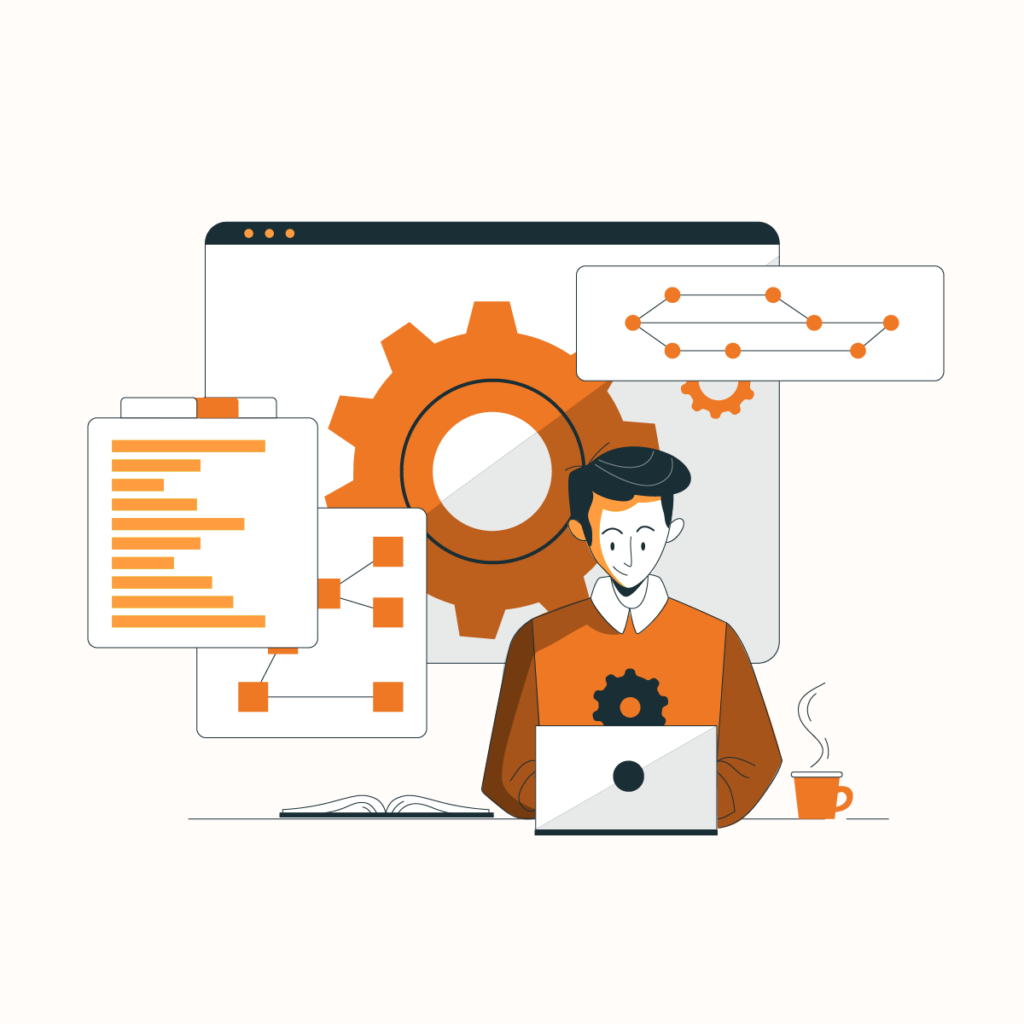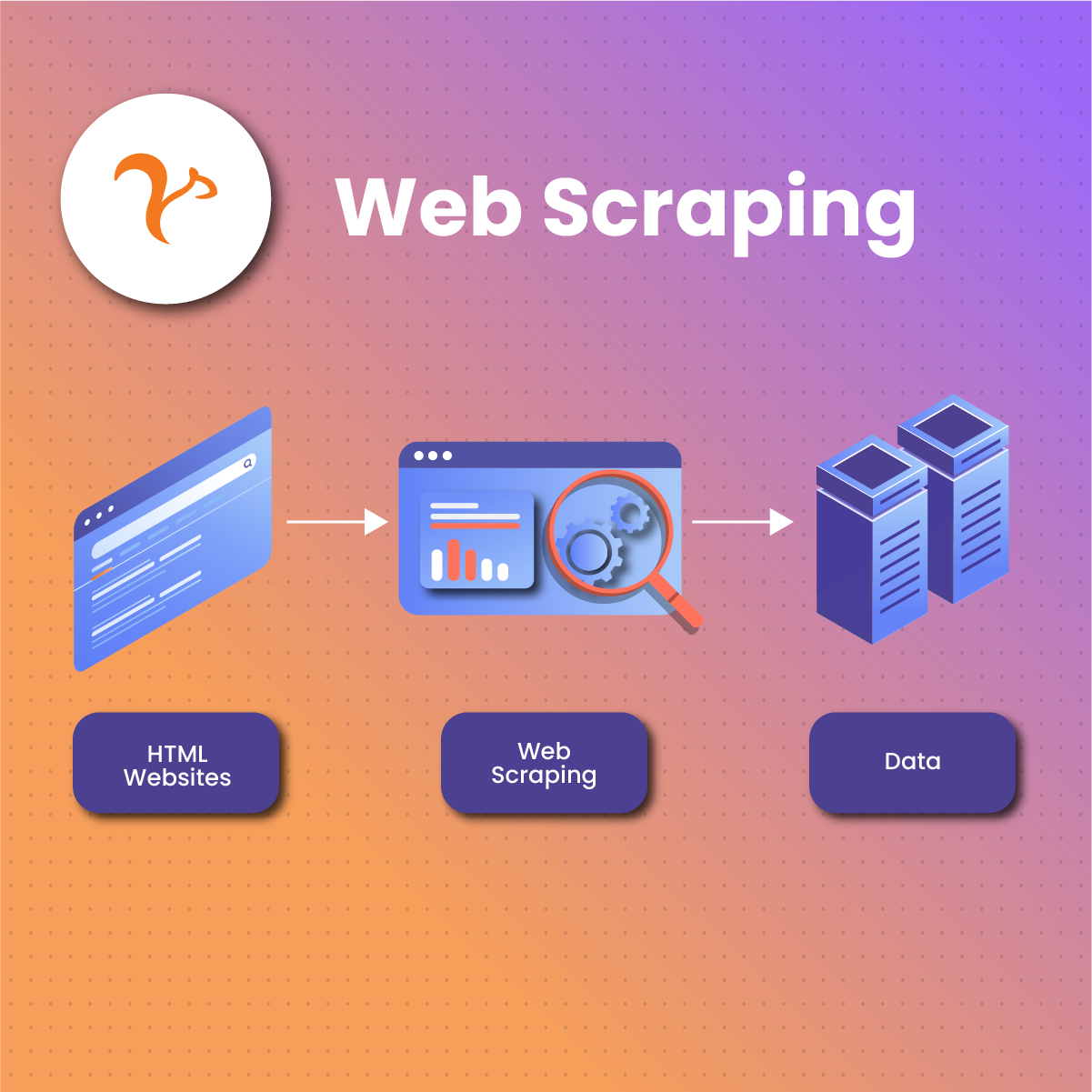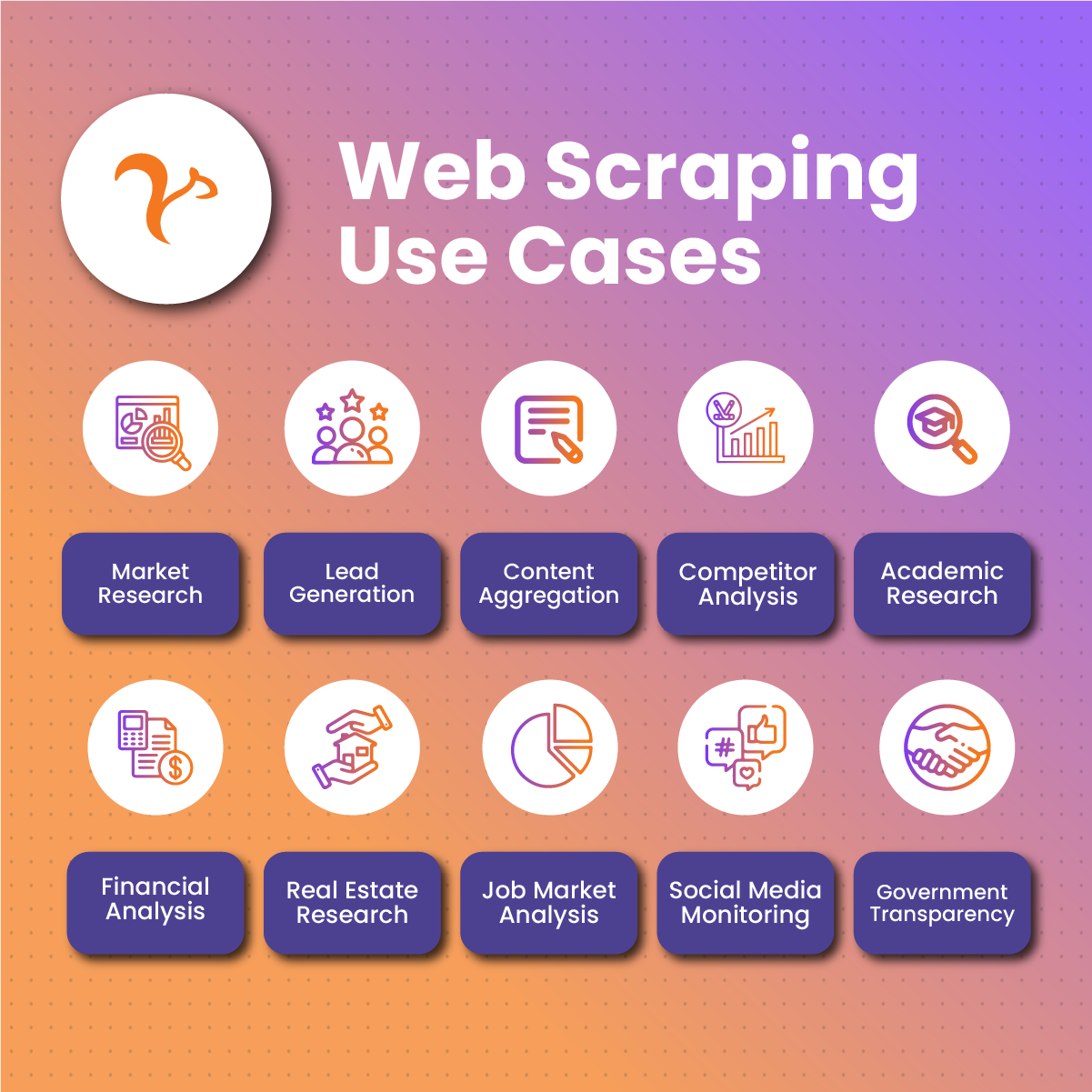In 2024, there are pieces of information hidden on the internet that can help you in the various aspects of your life as a business owner, researcher, journalist, or even as a developer. But how do you get hold of this information? Well, this can be done through web scraping. Web scraping is the practice of extracting data from websites. It involves using automated tools or scripts to retrieve specific information from web pages.
Web scraping is the modern-day data miner and understanding its usage is a valuable skill to acquire. Today you will learn what is web scraping & how it is used. So keep on reading to have this knowledge at your fingertips. Let’s begin!
What Is Web Scraping? 
Web scraping is the practice of extracting data from websites. It involves using automated tools or scripts to retrieve specific information from web pages. This information can then be analyzed, processed, and used for various purposes. Web scraping enables users to gather large amounts of data efficiently and can be used for several tasks such as market research, price monitoring, data analysis, and more. Additionally, there are several tools for effective and efficient data scraping such as Python, pandas, etc. Also, proxy types like residential proxies and static residential proxies can help you scrape data without the fear of getting blocked due to Geo-restrictions.
How Web Scraping Functions
Results can be obtained from web scraping when these three functions have taken effect.
Making An HTTP Request To A Server
As the first step of extracting data, the web scraper sends an HTTP request to the server hosting the website from which data needs to be extracted. This request contains information such as the URL of the web page, the type of request (e.g., GET or POST), and any additional parameters required, such as headers or authentication tokens. This is similar to a person who is visiting another person’s home. At the door, they don’t just barge inside. A request has to be made by knocking, to get the appropriate permission from the owner of the house before getting inside. So this is exactly what the scraper does first to extract the required data.
Extracting And Parsing The Website’s Code
After the website has thoroughly examined the request sent by the scraper, it then grants it access or denies the request as the case may be( do not be alarmed, this happens in a few seconds). However, once access is granted, the web scraper parses the HTML content to identify and extract the desired data. This process involves analyzing the HTML structure, locating specific elements (e.g., <div> tags with certain attributes), and extracting relevant text, links, or other content. The web scraper may perform additional processing or cleaning to format the data in a usable manner. This could involve removing unnecessary HTML tags, formatting dates or numbers, or structuring the data into a standardized format
Saving The Relevant Data Locally
Upon extracting the data, the next line of action of the web scraper is to save the relevant data locally. The data extracted is then stored as an Excel file, such as a .csv or .xls format. That’s it. Your data has been extracted.
How To Scrape Data
Since you now know how web scraping works, it is also important if you learn how to scrape data. But be aware that there are different tools for scraping data and they require different approaches, so we just dwell on the basics. Let’s dive straight into it
Find The URL you Want To Scrape
It is relevant that you find the URL you want to scrape. This depends on your web scraping task. What kind of information are you trying to obtain? When you identify that successfully then you go ahead and find a URL of the website that has that information, so you can start your web scraping task.
Inspect The Page
After finding the URL of the website you want to scrape, go ahead to inspect the page you want to scrape. This can be done by right-clicking the front end of the page. It will give you the option to “inspect element” or “view page source”. This should be done before you code your web scraper to carry out a particular web scraping task.
Identify The Data You Want To Extract
It’s now time to Identify the data you want to extract. Different tasks may require different methods based on the type of software used. But since this is about exploring the basics your main aim is to identify the unique tags that enclose (or ‘nest’) the relevant content (e.g. <div> tags).
Write The Necessary Code
As a developer, you might already be familiar with the different codes for web scraping especially when using the Python libraries. But if you don’t, that’s a lesson for another day. Moving on, your code will demonstrate and tell the bot exactly where to search for your required information. That’s exactly what the bot will do without hesitation except if you didn’t do something right while coding.
Store The Data
The final step you may want to take is to store the data that has just been extracted. One of the easiest and most convenient ways of doing this is to add the command to the lines of codes you already established and your bot will carry out the storing task swiftly. You are now good to go!
How Web Scraping Is Used 
In 2024, web scraping has numerous use cases across various industries and fields. Some common examples include:
Market Research
Web scraping is a powerful tool for market research especially for businesses in the e-commerce sector. By scraping data from e-commerce websites, businesses can monitor product prices, analyze competitor pricing strategies, and identify market trends. For example, a retail company may use web scraping to track the prices of its products as well as those of its competitors in real-time. This allows them to adjust their pricing strategies accordingly and stay competitive in the market.
Lead Generation
Lead generation is another popular use case for web scraping, particularly in sales and marketing. By extracting contact information from business directories, social media platforms, or job postings, businesses can generate leads for sales outreach or marketing campaigns. Similarly, recruiters and HR professionals can use web scraping to extract resumes and contact information from job postings or career websites to identify potential candidates for job openings.
Content Aggregation
In 2024, web scraping is also widely used for content aggregation, particularly in the media and publishing industries. By gathering news articles, blog posts, or other content from multiple sources, businesses can create curated content platforms or news aggregators to provide valuable insights to their audience. For example, a news website may use web scraping to collect articles from various online publications and organize them into categories or topics for easy access by readers. Similarly, a content marketing agency may use web scraping to gather industry-related articles and blog posts to share with their clients or publish on their website. This saves time and effort in manually curating content and ensures that the content is up-to-date and relevant to the target audience.
Competitor Analysis
Web scraping is also used for conducting competitor analysis across various industries. By collecting data on competitors’ products, pricing, marketing strategies, and customer reviews, businesses and individuals can gain valuable insights to inform their strategies and decision-making processes. For example, a retail company may use web scraping to track competitors’ product offerings, monitor changes in pricing or promotions, analyze their advertising campaigns, and assess customer sentiment through reviews and ratings. This information can help businesses identify opportunities for differentiation, optimize pricing strategies, and stay ahead of competitors in the market.
Academic Research
In academic research, web scraping is increasingly being used to gather data for studies, research papers, and data analysis projects. These researchers can extract data from online databases, scholarly articles, social media platforms, and other sources to analyze trends, conduct surveys, or explore new areas of inquiry. For example, social scientists may use web scraping to collect data from social media platforms to study user behavior, sentiment analysis, or the spread of information and misinformation.
Financial Analysis
Web scraping can be used in financial analysis by enabling the collection and analysis of vast amounts of financial data from various sources. This includes scraping stock market websites for real-time or historical stock prices, financial news sources for market updates and analysis, and government databases for economic indicators and regulatory filings. Financial analysts and investors can use this data to perform technical analysis, fundamental analysis, and quantitative modeling to identify investment opportunities, assess risks, and make informed trading decisions in 2024.
Real Estate Research
Real estate professionals and investors can use web scraping to gather data for market analysis and investment research in the real estate sector. For example, a real estate developer may use web scraping to analyze property listings and sales data to identify neighborhoods with high demand and potential for development. Similarly, rental property managers may scrape rental listings to assess market rents and vacancy rates, optimize pricing strategies, and identify potential investment properties.
Job Market Analysis
Web scraping is widely used for job market analysis to gather data on job postings from employment websites. By scraping job postings, researchers and labor market analysts can analyze job market trends, identify skills in demand, and gather salary information for specific industries or regions. This information can be valuable for workforce planning, career counseling, and policy development aimed at addressing labor market challenges.
Social Media Monitoring
Social media monitoring involves extracting data from social media platforms such as Twitter, Facebook, and Instagram for various purposes such as sentiment analysis, brand monitoring, and customer feedback analysis. By scraping social media posts, comments, and user profiles, businesses can gain insights into consumer behavior, brand perception, and market trends. Different businesses can analyze critics to gauge public opinion about their products or services, monitor mentions of their brand or competitors for reputation management, and identify influencers or brand advocates for targeted marketing campaigns.
Government Transparency
Web scraping is also used for promoting government transparency and accountability by accessing public records, legislative data, budget information, and other government-related data from official websites. When effective web scraping is done, journalists, activists, and researchers can monitor government activities, track policy changes, and analyze government spending. This information can help ensure transparency in governance and empower citizens to hold their elected officials accountable.
Tools Used For Web Scraping Task 
As we earlier mentioned, there are several tools you can use for web scraping tasks. These tools include
Scrapy
Scrapy is an open-source web crawling and scraping framework written in Python. It provides a flexible environment for building web scrapers and crawlers. Some of its features include built-in support for handling requests, managing concurrency, and parsing HTML using XPath or CSS selectors. However, scrappy allows users to define spider classes to specify how websites should be scrapped, including URL patterns, data extraction rules, and output formats. It supports asynchronous networking and can be scaled for large-scale scraping projects.
Beautiful Soup
Beautiful Soup is a Python library for parsing HTML and XML documents. It provides a simple and intuitive interface for extracting data from web pages. Users can navigate the parsed HTML tree using methods like find(), find_all(), and select(), making it easy to locate specific elements and extract desired content. Additionally, Beautiful Soup works well with other Python libraries like Requests for fetching web pages, and it can handle malformed HTML gracefully.
Selenium
Selenium is a popular web automation tool often used for testing web applications, but it can also be used for web scraping. Unlike traditional scraping tools, Selenium simulates a web browser and allows users to interact with dynamic web pages by executing JavaScript, clicking buttons, filling out forms, and more. It’s particularly useful for scraping websites that heavily rely on JavaScript for rendering content, as it ensures accurate data extraction. Selenium supports multiple programming languages, including Python, Java, and JavaScript.
Scrapy Cloud
Scrapy Cloud is a cloud-based platform specifically designed for deploying, managing, and scaling Scrapy spiders. It provides a user-friendly interface for scheduling spider runs, monitoring scraping jobs, and viewing scraped data. Scrapy Cloud offers features such as automatic IP rotation, built-in middleware for managing proxies and user agents, and support for deploying spiders as Docker containers. It’s particularly useful for large-scale scraping projects that require distributed crawling and efficient resource utilization.
Octoparse
Octoparse is a user-friendly web scraping tool that allows users to extract data from websites without writing any code. It features a point-and-click interface for selecting elements on web pages and defining extraction rules, making it accessible to users with no programming experience. Octoparse supports various data formats and output options, including CSV, Excel, and databases. It offers scheduling and automation capabilities, allowing users to schedule scraping tasks to run at specific times or intervals.
ParseHub
ParseHub is another visual web scraping tool that enables users to extract data from websites using a point-and-click interface. It provides advanced features such as automatic detection of pagination, dynamic data extraction, and integration with APIs. ParseHub allows users to build complex scraping projects with multiple levels of nesting and conditional logic. It offers cloud-based hosting for scraping projects, along with scheduling and automatic email notifications for monitoring scraping jobs.
Frequently Asked Questions
What Is Web Scraping?
Web scraping is the practice of extracting data from websites. It involves using automated tools or scripts to retrieve specific information from web pages. This information can then be analyzed, processed, and used for various purposes. Web scraping enables users to gather large amounts of data efficiently and can be used for several tasks such as market research, price monitoring, data analysis, and more.
How Can I Get Started With Web Scraping?
To get started with web scraping, you can begin by learning basic Python, HTML, CSS, and XPath or CSS selectors for data extraction. Then, explore web scraping libraries and tools in your preferred programming language and practice scraping simple websites to familiarize yourself with the process. To avoid common challenges like IP blocking use proxy types like ISP and mobile proxy. NetNut is one of the best providers offering these services.
How Is Web Scraping Used In 2024?
In 2024, web scraping will be used across various industries and fields for tasks such as market research, lead generation, content aggregation, competitor analysis, academic research, financial analysis, real estate research, job market analysis, social media monitoring, and government transparency among others.
Conclusion
In conclusion, web scraping in 2024 opens doors to several opportunities as you can gain access to a whole lot of hidden treasures on the Internet. If you are a beginner, you can learn more about web scraping by exploring additional content like this article on our blog. Furthermore, if you’re a developer looking to engage in web scraping tasks without encountering major issues such as geographical restrictions or blocking, consider integrating with NetNut. We offer various services, including different proxy types such as rotational proxies, which are essential for smooth data collection.









